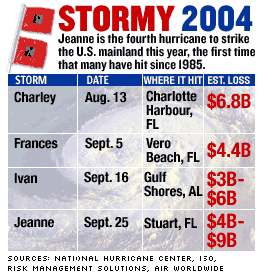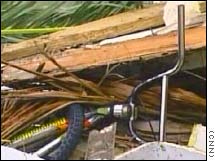NEW YORK (CNN/Money) -
Hurricane Jeanne could end up being the most expensive storm to hit the United States in a year of very expensive storms.

In addition to the effect on millions of homeowners, Jeanne, like the earlier storms, has affected two of Florida's biggest industries -- orange growers and tourism.
Risk Management Solutions, a catastrophe modeling firm that works for the insurance industry, estimated Sunday that Jeanne could cause $4 billion to $8 billion in insured losses, while rival firm AIR Worldwide put the forecast a bit higher, at $5 billion to $9 billion.
A loss at the upper end of those ranges would be second only to Hurricane Andrew, which in 1992 caused $20 billion in insured losses, adjusted for inflation.
Just before midnight Saturday, Jeanne slammed into Stuart, Fla., about 10 miles from where Frances hit Labor Day weekend, killing six and tracking a path remarkably similar to Frances. Jeanne also crossed the path of Hurricane Charley, which hit the state Aug. 13.
Jeanne had sustained winds of 120 mph. But by Monday morning it had weakened to tropical storm status and was expected to be downgraded to a tropical depression later in the day. (Click here for CNN.com hurricane coverage.)
Jeanne's path being so similar to that of Frances, and just three weeks later, is adding to estimated losses, RMS meteorologist Kyle Beatty said. Many buildings damaged by Frances have not been completely repaired and so are susceptible to further damage, he added.
"If a roof hasn't been fully fixed, there's greater risk of water damage," he said.
In addition, Beatty said some insurers were allowing customers hit by both Frances and Hurricane Charley to count the losses as a single event, not forcing them to pay two separate deductibles, which in many cases range from 2 to 5 percent of a home's insured value. A similar policy for Jeanne would increase insured losses, he said.
Another factor driving up losses could be the shortage of contractors and some supplies needed to make repairs.
Leading businesses hit
Many of the state's largest industries, including oranges and tourism, took another hit from Jeanne after reeling from two of the previous storms.
Orange juice futures jumped the 5-cent limit for nearby contracts on commodities exchanges, said Jason Roose, analyst for US Commodities Inc. in West Des Moines, Iowa.
 |
|
| Jeanne killed 1,300 people in Haiti before slamming into Florida, where it killed at least six, left 2.6 million people without power and ravaged property. |
That pushed the November contract to 83.75 cents a pound, leaving prices overall up nearly 20 percent since July, before the current round of storms started.
"There continues to be substantial damage in production of orange juice," Roose said. "We don't know the extent, but we know it can take two or three years to replace a tree damaged or destroyed in a hurricane."
Roose said lumber futures have retreated since hitting a high Aug. 18, shortly after Charley was the first hurricane to hit the state. That's because some contractors are stopping work elsewhere in the country to go to Florida, easing demand outside the state.
Roose said that while there may be some damage to forests in northern Florida and Georgia from the storms, lumber prices are being driven more by perception of demand rather than an actual decline in supply.
Meanwhile, tourism has also been hurt by the storms. Disney World in Orlando closed early Saturday and remained closed Sunday, the third hurricane-related closing of the season. That's the worst storm-related disruption since the theme park opened in 1971.
But a spokeswoman for the resort said damage to the parks was minimal, mostly trees and plants, and that it had opened for business as normal Monday.
Overall, hotels in Florida may actually getting a bit of a short-term boost from the storms in what is typically a slow period for the industry, said Tom Flanigan, spokesman for Visit Florida, the state government's tourism division.
"It's mostly displaced residents. You've also got an awful lot of utility crews, insurance adjusters flooding into the state. The attraction segment has been off because a lot of people have been deferring business," he said.
But Flanigan said the state is more concerned over longer-term damage to the tourism business -- people canceling conventions or meetings in the upcoming months or during next year's hurricane season -- due to this year's storms.
"We're a bit more concerned what kind of long-term impact the storms will have on the image of the state as tourism destination," he said, adding Florida tourism officials have started market research elsewhere in the country to gauge opinion.
Officials are hoping this summer's problems won't affect the traditional peak season in the winter and early spring.
"There is a recognition that hurricanes generally don't happen once you get past the end of November," he said.
Even if Jeanne's insured losses are at the low end of estimates, it is to be either the fifth or sixth most expensive storm in U.S. history. There are still no specific damage estimates available for Hurricane Ivan.
And total insured losses -- now estimated at $18 billion to $26 billion -- will make this among the most expensive years for insurers. This is the first year since 1985 in which four storms make it to the U.S. mainland at hurricane strength.
Analysts with insurance rating agency AM Best said earlier this month that the insurance industry and the reinsurance industry should both have sufficient resources to handle the large claims being seen this year.
One major retailer, Federated Department Stores (FD: Research, Estimates), said Monday that Jeanne added to its hurricane-related drop in sales. The operator of the Macy's and Bloomingdale's chains said it saw a $10 million hit to sales and a small hit to earnings from the latest storm.

|

